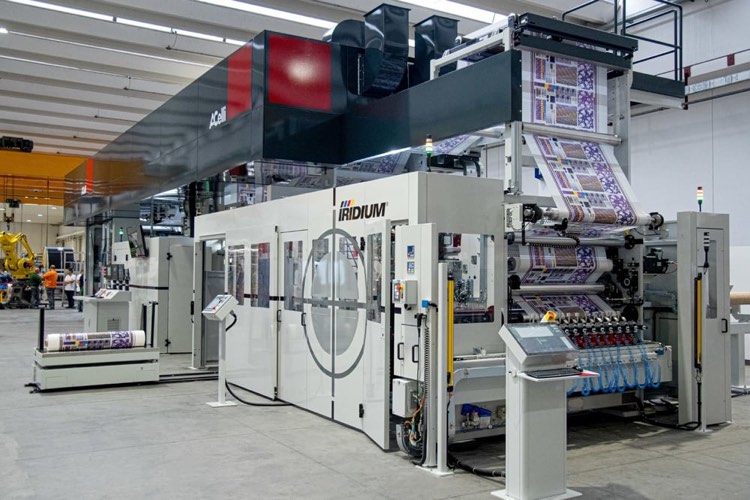PORCARI – One of the greatest challenges in the printing of material components for absorbent hygiene products (AHPs) is ensuring a constant print repeat length.
Spunmelt nonwovens and LDPE films employed in AHPs are characterised by very low grammages and are therefore extremely sensitive to factors such as tension and temperature, says A.Celli, the Italian developer of Iridium flexo printing technology.
These materials are subjected to a determined tension during the printing process and if not correctly set up and maintained, it can cause variations in the print repeat length outside the defined tolerances, with the result that the non-compliant reel must be discarded, or even worse, that the entire batch of reels in which the defective reel was present becomes the subject of dispute by the converter.
There are three main factors that affect the print repeat length – the tensioning of the material during the entire process, the structural stability of the machine and the temperature of the air used in drying.
Tension control
Proper and constant tensioning of the specific material before, during and after the printing process is of the utmost importance when it comes to ensuring a constant print repeat length.
Overall, the printing machine can be divided into three tension zones – lengths in which the web is under the same tension – the unwind zone, intermediate tension zones (typically multiple) and the rewind zone. In order to properly control the tension in any of the zones, it must be measured or approximated by some means.
With an integrated slitter-rewinder, tension is checked at five different points along the process – unwinder, in-feed nip roll, printing unit, out-feed nip roll, winder pulling unit and winder. Otherwise, the print repeat length is checked immediately after the winder pulling unit, as close to the winder as possible.
Each of the nip rolls are responsible for maintaining the proper, uniform tension of the material throughout the entire process. If at any of these points a different tension is detected, the flexographic printer will automatically make the required corrections in order to achieve the desired repeat length. The preferred technologies for precise tension measurement are the load cell (tension transducer) or the dancing rolls.
Structural stability
The structural stability of the machine also impacts on the tensioning of the material, and consequently the repeat length during the printing process. Since this stability is the result of a balance between all the electronic and mechanical parts of which the printer is composed, there are many different factors to take into consideration.
Each independent colour deck, for example, must operate at the same speed as the others in relation to the specific material being processed. To achieve this, it is necessary to ensure that the master encoder positioned on the central impression drum communicates the speed at which its motor must operate to the encoder of each colour deck.
The angular position of each colour deck in relation to the angular position of the central impression drum must also be correct. In order to achieve this, the master encoder will detect and communicate the position of the drum to the encoders of each colour deck every 3 milliseconds and the individual groups will correct the misalignment and in turn send feedback to the master encoder. Since this happens for all colour decks at the same time, the machine must be able to make the necessary corrections in the fastest and most efficient way possible.
The motor of each colour deck must have an appropriate weight in relation to the weight of the plate holder cylinder and its support system. If this doesn’t happen due to an incorrect motor sizing, the colour deck will not be able to make the necessary corrections communicated by the master encoder.
The mechanical rigidity of the coupling between the colour deck motor and the plate holder cylinder support system must be such that the motor can properly transfer the command sent by the encoder of the colour deck to the cylinder. In order to achieve this, A.Celli uses a rigid and direct coupling between the motor shaft and the plate holder cylinder shaft, without using gearboxes or other devices.
Air temperature
Finally, print repeat length can be affected by the temperature of the air used to dry the ink.
During this part of the process the materials pass through a section of the machine called the drying hood, where they are transported by motorised rollers and the inks are dried thanks to the use of air emitted by nozzles positioned at each roll. Since the more a material is heated the more easily it will stretch under tension, the temperature inside the drying hoods must be accurately set.
The variables of the drying process are different depending on the inks used and the drying time for water-based inks is significantly slower than with solvent-based inks.
A.Celli has designed the drying hoods of the Iridium flexo printing machine specifically to dry these inks in the most efficient and quickest way possible, without using temperatures that could affect the structure of the material and without slowing down the printing process. In addition, the flow rate and speed of the air emitted by the nozzles, designed for sensitive materials, contributes to improving the performance of the hood system.
Ultimately, to obtain and maintain constant print quality, some essential conditions must be met – that the material is of high quality, the tension is correct and maintained throughout the printing process, the machine is structurally stable, and the drying process is suitable for the type of ink and material used. All of this is critical to ensuring the production of a high quality, defect-free printed reel.
